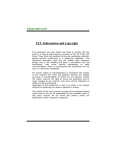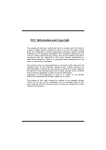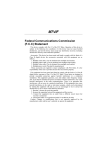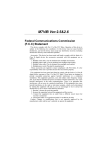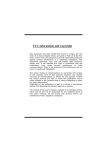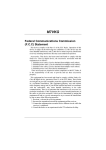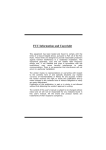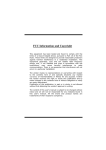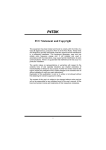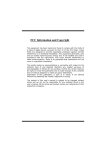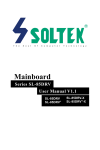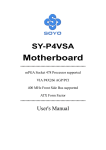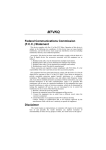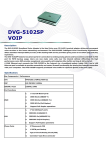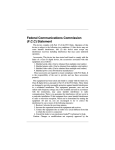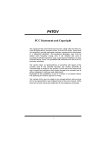Download Biostar U8568 Owner's Manual
Transcript
FCC Information and Copyright This equipment has been tested and found to comply with the limits of a Class B digital device, pursuant to Part 15 of the FCC Rules. These limits are designed to provide reasonable protection against harmful interference in a residential installation. This equipment generates, uses and can radiate radio frequency energy and, if not installed and used in accordance with the instructions, may cause harmful interference to radio communications. There is no guarantee that interference will not occur in a particular installation. The vendor makes no representations or warranties with respect to the contents here of and specially disclaims any implied warranties of merchantability or fitness for any purpose. Further the vendor reserves the right to revise this publication and to make changes to the contents here of without obligation to notify any party beforehand. Duplication of this publication, in part or in whole, is not allowed without first obtaining the vendor’s approval in writing. The content of this user’s manual is subject to be changed without notice and we will not be responsible for any mistakes found in this user’s manual. All the brand and product names are trademarks of their respective companies. Table of Contents Notice .............................................................................................1 Mainboard Features ...............................................................2 1. Features Introduction......................................................................... 2 1-1. Hardware............................................................................................................ 2 1-2. BIOS & Software............................................................................................ 5 1-3. Package Contents.......................................................................................... 5 2. Mainboard Configuration................................................................... 6 2-1. Layout of U8568 ............................................................................................ 6 2-2. Component Index ......................................................................................... 7 3. CPU Configuration ............................................................................... 8 3-1. CPU Socket 478 Configuration Steps:............................................... 8 3-2. CPU Fan Header: JCFAN1....................................................................... 10 3-3. System Fan Header: JSFAN1 (Optional) ....................................... 10 3-4. Frequency Selection: JCLK1.................................................................. 10 3-5. Clock Ratio Selection: JCLK2................................................................ 10 4. Jumpers, Headers & Connectors.................................................. 11 4-1. Front Panel Connector: JPANEL1 ....................................................... 12 4-2. ATX 20-pin Power Connector: JATXPWR1.................................... 14 4-3. ATX 12V Power Connector: JATXPWR2 ......................................... 14 4-4. Hard Disk Connectors: IDE1/IDE2.................................................... 15 4-5. Floppy Disk Connector: FDD1.............................................................. 15 4-6. Wake On LAN Header: JWOL1 ............................................................ 15 4-7. Clear CMOS Jumper: JCMOS1............................................................. 16 i Table of Contents 4-8. CNR Codec Primary/Secondary Selection: JCODECSEL....... 16 4-9. Front USB Header: JUSB20B (with USB2.0 spe) (Optional)17 4-10. Front USB Header: JUSB3 (with USB1.0 spe)......................... 17 5. RAM Module Configuration ............................................................. 18 5-1. DIMM Features.............................................................................................. 18 5-2. DIMM Module Configuration.................................................................. 19 6. Peripheral Port Features ................................................................. 21 6-1. PS/2 Mouse / Keyboard Connector: JKBMS1 ............................. 21 6-2. USB & LAN Port Connectors: JUSBLAN1 ....................................... 22 6-3. Serial and Parallel Interface Ports...................................................... 24 6-4. Game (Joystick/MIDI) Port Connector: JAUD_GAME ............ 26 6-5. Audio Port Connectors: JSPKR1/JLIN1/JMIC1............................ 26 6-6. Audio Subsystem......................................................................................... 27 ii Mainboard Features Notice Introduction of system This mainboard is designed to take advantage of the latest industry technology to provide you with the ultimate solution in data processing. In the tradition of its predecessors, this mainboard continues a commitment to reliability and performance and strives for full compliance and compatibility with industry software and hardware standards. U8568 Features: 1.Contains on board I/O facilities that include two serial ports, a parallel port, a PS/2 mouse port, a PS/2 keyboard port, audio ports, USB ports and a game port. 2.Contains on board IDE facilities for IDE devices such as hard disks and CD-ROM Drives. 3.Supports the Intel Pentium ® 4 processor, a leading edge processor. Complies with PC ATX form factor specifications. 4.Supports popular operating systems such as Windows NT, Windows 2000, Windows ME, Windows XP, Novell, LINUX and SCO UNIX. 1 Mainboard Features Mainboard Features 1. Features Introduction 1-1. Hardware CPU: 1.Provides Socket-478. ® 2.Supports the Intel Pentium 4 processor providing the new generation power for high-end workstations and servers. Speed: 1.Running at 400/533 MHz Front Side Bus frequency, use chipset VT8753E (P4X266E) (Optional). 2.Running at 400 MHz Front Side Bus frequency, use chipset VT8753 (P4X266). 3.Supports up to 2.53 GHz CPU core speeds. 4.The 33MHz 32 bit PCI 2.2 compliant. 5.The 66MHz AGP 2.0 compliant interface supports 1x, 2x and 4x data transfer mode. Chipset: 1.Chipset – North Bridge: VIA VT8753/ E (P4X266/ E) South Bridge: VIA VT8233A. 2.Chipset – Winbond W83697HF. DRAM Memory: 1.Supports 100MHz or 133MHz SDRAM devices 2.Supports 200MHz, 266MHz DDR SDRAM devices. 3.Supports 64Mb, 128Mb, 256Mb and 512Mb technologies for x8 and 16 devices. 4.Max of 2 Double-Sided DIMMs SDRAM or DDR SDRAM with unbuffered / Registered. 5.The largest memory capacity is 2 GB. 2 Mainboard Features Shadow RAM: Motherboard is equipped with a memory controller providing shadow RAM and support for ROM BIOS. Green Functionality: 1.Supports Award BIOS ™ power management functionality. 2.Has a power down timer from 1 to 15 minutes. 3.Wakes from power saving sleep mode with any keyboard or mouse activity. BUS Slots: 1.Contains 1 AGP slot. 2.Contains 1 CNR slot. 3.Contains 1 ACR slot 4.Contains 5 32-bit PCI bus slots Flash Memory: 1.Supports flash memory functionality. 2.Supports ESCD functionality. Built in IDE Facilities: 1.Supports four IDE hard disk drives. 2.Supports PIO Mode 4, Master Mode, and high performance hard disk drives. 3.Supports disk transfer rates up to 133 MB/second. 4.Supports Ultra DMA 33, Ultra DMA 66, Ultra DMA 100, Ultra DMA 133 Bus Master Modes. 5.Supports IDE interface with CD-ROM. 6.Supports high capacity hard disk drives. 7.Supports LBA mode. 3 Mainboard Features AC’97 Sound Codec Onboard: 1.AC-LINK protocol comfliance. 2.Compliant with AC’97 2.2 specification. 3.18-bit full duplex stereo ADC, DACs. 4.SNR>95 Bb throughmixer and DAC. 5.AC-3 playback required for PVD applications. I/O facilities: 1.One multi-mode Parallel Port capable of supporting the following specifications: Standard & Bidirection Parallel Port. Enhanced Parallel Port (EPP). Extended Capabilities Port (ECP). Normal 2.Supports two serial ports, 16550 UART. 3.Supports Infrared Data Transmission using IrDA. 4.Supports PS/2 mouse and PS/2 keyboard. 5.Supports 360KB, 720KB, 1.2MB, 1.44MB, and 2.88MB floppy disk drives. Universal Serial Bus: 1.Supports two back panel Universal Serial Bus Ports and two front panel Universal Serial Bus Ports. 2.Supports 480 MHz USB (2.0) (optional). Hardware Monitor Function: 1.Monitors CPU Fan Speed. 2.Monitors System Voltage (optional). Dimensions (ATX form-factor): 24.5cm x 30.5cm (WxL) 4 Mainboard Features 1-2. BIOS & Software 1.Award legal BIOS. 2.Supports APM1.2. 3.Supports USB Function. 4.Supports ACPI. Operating System: Offers the highest performance for MS-DOS, Windows NT, Windows 2000, Windows ME, Windows XP, Novell, LINUX, and SCO UNIX etc. 1-3. Package Contents 1.HDD Cable. 2.FDD Cable. 3.Flash Memory Writer for BIOS Update. 4.USB Cable (Optional). 5.Rear I/O Panel for ATX Case (Optional). 6.Fully Setup Driver CD. 5 Mainboard Features 2. Mainboard Configuration 2-1. Layout of U8568 JKBMS1 Mouse & KB JUSBLAN1 CPU1 Socket 478 USB & LAN JCOM1 JPRNT 1 DDR1 DDR2 SDR1 SDR2 Parallel Port CPU Game Port MIC Line Speaker In In O ut JCOM2 JVGA1 JATXPWR2 U13 JATXPWR1 2 1 VT8753/ E (P4X266/ E) 4 3 JAUD_GAME U16 Realtek RTL 8100 JAUDIO1 2 1 10 9 AGP SLOT PCI1 PCI SLOT JUSB3 PCI2 JCDIN2 1 1 1 PCI SLOT VT8233A JTAD1 JCDIN1 2 1 U19 PRIMARY IDE CONN. PCI3 1 PCI SLOT 10 9 SECONDA RY IDE CONN. JCLK2 PCI4 BIOS PCI SLOT FLOPPY DISK CONN. PCI5 PCI SLOT VT6202 USB2.0 JUSB20B 2 Winbond W83697HF ACR1 1 AGP SLOT CNR1 CNR SLOT JCMOS1 1 JCODECSEL 1 JWOL1 1 6 10 9 JSFAN1 BAT1 2 1 JPANEL1 24 23 1 Mainboard Features 2-2. Component Index 7 Mainboard Features 3. CPU Configuration 3-1. CPU Socket 478 Configuration Steps: CPU Fan CPU 1. Pull the lever sideways away from the socket then raise the lever up to a 90-degree angle. 2. Locate Pin A in the socket and look for the white dot or cut edge in the CPU. Match Pin A with the white dot/cut edge then insert the CPU. 3. Press the lever down. Then Put the fan on the CPU and buckle it and put the fan’s power port into the JCFAN1, then to complete the installation. 8 Mainboard Features CPU Configuration Layout 2 1 4 3 JCLK2 1 JSFAN1 1 9 Mainboard Features 3-2. CPU Fan Header: JCFAN1 Pin No. Assignment 1 Ground 2 +12V 3 Sense 3-3. System Fan Header: JSFAN1 (Optional) Pin No. Assignment 1 Ground 2 +12V 3 Sense 3-4. Frequency Selection: JCLK1 (Optional) CPU Clock PIN 1-2 PIN 3-4 100MHz OFF ON 133MHz ON OFF 3-5. Clock Ratio Selection: JCLK2 (Optional) JCLK2 1 Assignment 3 100 MHz 1-2 Closed 1 3 133 MHz 2-3 Closed 10 Mainboard Features 4. Jumpers, Headers & Connectors JATXPWR1 JATXPWR2 2 1 10 JUSB3 9 IDE 1-2 FDD1 JUSB20B 2 10 1 BAT1 JCODECSEL 1 2 1 JWOL1 JCMOS1 1 1 11 9 JPANEL1 24 23 Mainboard Features 4-1. Front Panel Connector: JPANEL1 Pin Assignment Function Pin Assignment No. No. Function 1 +5V 2 Sleep Control Sleep 3 NA Speaker 4 Ground Button 5 NA Connector 6 NA NA 7 Speaker 8 Power LED (+) 9 HDD LED (+) Hard Drive 10 Power LED (+) POWER 11 HDD LED (-) LED 12 Power LED (-) LED 13 Ground Reset 14 Power Button 15 Reset Control Button 16 Ground 17 NA 18 KEY 19 NA IrDA 20 KEY IrDA 21 VCC5 Connector 22 Ground Connector 23 IRTX 24 IRRX Power-on Button SPK (Speaker Connector) An offboard speaker can be installed on the motherboard as a manufacturing option. An offboard speaker can be connected to the motherboard at the front panel connector. The speaker (onboard or offboard) provides error beep code information during the Power On Self-Test when the computer cannot use the video interface. The speaker is not connected to the audio subsystem and does not receive output from the audio subsystem. RST (Reset Button) This connector can be attached to a momentary SPST switch. This switch is usually open and when closed will cause the motherboard to reset and run the POST (Power On Self Test). 12 Mainboard Features POW-LED (Power LED Connector) This connector can be attached to an LED on the front panel of a computer case. The LED will illuminate while the computer is powered on. HLED (Hard Drive LED Connector) This connector can be attached to an LED on the front panel of a computer case. The LED will flicker during disk activity. This disk activity only applies to those IDE drives directly attached to the system board. IR (Infrared Connector) This connector is used to attach to an infrared sensing device. After the IrDA interface is configured, connectionless data transfer to and from portable devices such as laptops, PDAs is possible. SLP (Sleep/Green Button) This connector is used to conserve energy by powering down the monitor and the hard disk when not in use. To configure this option, you need to connect a button from the front panel to this connector. Depressing the button will power down the monitor and hard drives until the system is invoked by any keyboard activity, mouse activity, modem activity or when the sleep button is depressed again. APM (Advanced Power Management) must be enabled in the system BIOS and the APM driver must be loaded. ON/OFF (Power Button) This connector can be attached to a front panel power switch. The switch must pull the Power Button pin to ground for at least 50 ms to signal the power supply to switch on or off. (The time required is due to internal debounce circuitry on the system board). At least two seconds must pass before the power supply will recognize another on/off signal. 13 Mainboard Features 4-2. ATX 20-pin Power Connector: JATXPWR1 PIN Assignment PIN Assignment 1 3.3V 11 3.3V 2 3.3V 12 -12V 3 Ground 13 Ground 4 5V 14 PS_ON 5 Ground 15 Ground 6 5V 16 Ground 7 Ground 17 Ground 8 PW_OK 18 -5V 9 5V_SB 19 5V 10 12V 20 5V 4-3. ATX 12V Power Connector: JATXPWR2 PIN Assignment PIN Assignment 1 12V 3 Ground 2 12V 4 Ground 14 Mainboard Features 4-4. Hard Disk Connectors: IDE1/IDE2 This mainboard has a 32-bit Enhanced PCI IDE Controller that provides PIO Mode 0~4, Bus Master, and Ultra DMA / 33, Ultra DMA / 66,Ultra DMA / 100 functionality. It has two HDD connectors IDE1 (primary) and IDE2 (secondary). • IDE1 (Primary IDE Connector) The first hard drive should always be connected to IDE1. IDE1 can connect a Master and a Slave drive. You must configure the second hard drive on IDE1 to Slave mode by setting the jumper accordingly. • IDE2 (Secondary IDE Connector) The IDE2 controller can also support a Master and a Slave drive. The configuration is similar to IDE1. The second drive on this controller must be set to slave mode. 4-5. Floppy Disk Connector: FDD1 The motherboard provides a standard floppy disk connector (FDC) that supports 360K, 720K, 1.2M, 1.44M and 2.88M floppy disk types. This connector supports the provided floppy drive ribbon cables. 4-6. Wake On LAN Header: JWOL1 Pin No. Assignment 1 5V SB 2 Ground 3 Wake up 15 Mainboard Features 4-7. Clear CMOS Jumper: JCMOS1 JCMOS1 1 Assignment 3 1-2 Closed 1 Normal Operation (default) 3 Clear CMOS Data 2-3 Closed The following procedures are for resetting the BIOS password. It is important to follow these instructions closely. ※ Clear CMOS Procedures: 1. 2. 3. 4. 5. 6. Remove AC power line. Make JCMOS1 (2-3) closed. Wait for five seconds. Make JCMOS1 (1-2) closed. Let AC power on. Reset your desired password or clear the CMOS data. 4-8. CNR Codec Primary/Secondary Selection: JCODECSEL Pin No. Assignment 1-2 On-board Primary Codec 2-3 CNR Primary Codec 16 Mainboard Features 4-9. Front USB Header: JUSB20B (with USB2.0 spe) (Optional) (JUSB20B) Pin Assignment 1 +5V(fused) 3 USBP35 USBP3+ 7 Ground 9 KEY Pin 2 4 6 8 10 Assignment +5V(fused) USBP4USBP4+ Ground NC 4-10. Front USB Header: JUSB3 (with USB1.0 spe) (JUSB3) Pin 1 3 5 7 9 Assignment +5V(fused) USBP2USBP2+ Ground KEY Pin 2 4 6 8 10 17 Assignment +5V(fused) USBP3USBP3+ Ground NC Mainboard Features 5. RAM Module Configuration 5-1. DIMM Features DRAM Access Time: 2.5V DDR SDRAM PC1600/ PC2100 Type required. or 3.3V SDR SDRAM PC100/PC133 Type required. DDR Devices used on DIMM 1 DIMM DIMM 2 (2 Rows) (2 Rows) x64/ x72 x64/ x72 64M (4Mx4x4banks) 256 M 256 M 64M (2Mx8x4banks) 128 M 128 M 64M (1Mx16x4banks) 64 M 64 M 128M (8Mx4x4banks) 512 M 512 M 128M (4Mx8x4banks) 256 M 256 M 128M (2Mx16x4banks) 128 M 128 M 256M (8Mx8x4banks) 512 M 512 M 256M (4Mx16x4banks) 256 M 256 M 512M (8Mx16x4banks) 512 M 512 M SDR Devices used on DIMM 1 DIMM 2 DIMM (2 Rows) (2 Rows) 64M (4Mx4x4banks) 64M (2Mx8x4banks) 64M (1Mx16x4banks) 128M (8Mx4x4banks) 128M (4Mx8x4banks) 128M (2Mx16x4banks) 256M (8Mx8x4banks) 256M (4Mx16x4banks) 512M (8Mx16x4banks) x64/ x72 x64/ x72 256 M 256 M 128 M 128 M 64 M 64 M 512 M 512 M 256 M 256 M 128 M 128 M 512 M 512 M 256 M 256 M 512 M 512 M 18 Mainboard Features 5-2. DIMM Module Configuration 1. The DIMM socket has a “Plastic Safety Tab” and the DIMM memory module has an asymmetrical notch”, so the DIMM memory module can only fit into the slot in one direction. 2. Push the tabs out. Insert the DIMM memory modules into the socket at a 90-degree angle then push down vertically so that it will fit into place. 3. The Mounting Holes and plastic tabs should fit over the edge and hold the DIMM memory modules in place. SDR 19 Mainboard Features DDR 20 Mainboard Features 6. Peripheral Port Features JKBMS1 PS/2 Mouse PS/2 Keyboard JUSBLAN1 JPRNT1 LAN (Optional) USB JAUD_GAME Game Port Parallel COM1 COM2 JCOM1 JCOM2 Speaker Out Line In Mic In JSPKR1 JLIN1 JMIC1 6-1. PS/2 Mouse / Keyboard Connector: JKBMS1 The motherboard provides a standard PS/2 mouse / Keyboard mini DIN connector for attaching a PS/2 mouse. You can plug a PS/2 mouse / Keyboard directly into this connector. The connector location and pin definition are shown below: PS/2 Mouse / Keyboard Connectors Pin Assignment 1 Data 2 No connect 3 Ground 4 +5 V (fused) 5 Clock 6 No connect 21 Mainboard Features 6-2. USB & LAN Port Connectors: JUSBLAN1 6-2-1. USB Connectors: USB Connector (the below one) Pin Assignment 1 +5 V (fused) 2 USBP1- 3 USBP1+ 4 Ground USB Connector (the above one) Pin Assignment 5 +5 V (fused) 6 USBP2- 7 USBP2+ 8 Ground 22 Mainboard Features 6-2-2. LAN Port Connector: (Optional) This connector allows you to connect to the Internet through a Local Area Network (LAN). You can set up the connection by entering account information provided by your ISP. LAN Port Connector Pin Assignment 9 VCC3 10 TD+ 11 TD- 12 RD+ 13 RD- 14 NC 23 Mainboard Features 6-3. Serial and Parallel Interface Ports This system comes equipped with two serial ports and one parallel port. Both types of interface ports will be explained in this chapter. 6-3-1. The Serial Interface: JCOM1/ JCOM2 The serial interface port is sometimes referred to as an RS-232 port or an asynchronous communication port. Mice, printers, modems and other peripheral devices can be connected to a serial port. The serial port can also be used to connect your computer with another computer system. Connectivity The serial ports can be used in many ways, and it may be necessary to become familiar with the pinout diagram. The following chart gives you the function of each pin on the 9-pin connector and some of the 25-pin connector. This information can be used when configuring certain software programs to work with the serial ports. Signal Name DB9 PIN DB25 PIN DCD Data Carrier Detect 1 8 RX Receive Data 2 3 TX Transmit Data 3 2 DTR Data Terminal Ready 4 20 GND Signal Ground 5 7 DSR Data Set Ready 6 6 RTS Request to Send 7 4 CTS Clear to Send 8 5 RI Ring Indicator 9 22 24 Mainboard Features 6-3-2. Parallel Interface Port: JPRNT1 Unlike the serial ports, parallel interface port has been standardized and should not present any difficulty interfacing peripherals to your system. Sometimes called centronics port, the parallel port is almost exclusively used with printers. The parallel port on your system has a 25-pin, DB25 connector. The pinout for the parallel port are shown in the table below. Pin 1 2 3 4 5 6 7 8 9 10 11 12 13 14 15 16 17 18 19 20 21 22 23 24 25 Signal -Strobe Data 0 Data 1 Data 2 Data 3 Data 4 Data 5 Data 6 Data 7 -Ack Busy Paper Empty +Select -Auto FDXT -Error -Init -SLCTN Ground Ground Ground Ground Ground Ground Ground Ground 25 Mainboard Features 6-4. Game (Joystick/MIDI) Port Connector: JAUD_GAME This connector allows you to connect a joystick or game pad for playing computer games. Also, you may play or edit professional music by connecting MIDI devices. Game/Joystick/MIDI 6-5. Audio Port Connectors: JSPKR1/JLIN1/JMIC1 Speaker Out Line In Mic In 1. Speaker Out is used to connect speakers or headphones for audio output. 2. Line In can be connected to the external CD player, Tape player or other audio devices for audio input. 3. Mic In is used to connect a microphone, which allows you to input sounds and voices. 26 Mainboard Features 6-6. Audio Subsystem JAUDIO1 2 1 10 9 JTAD1 1 JCDIN2 1 1 JCDIN1 27 Mainboard Features 6-6-1. CD-ROM Audio-In Header: JCDIN1 Pin No. Assignment 1 Left Channel Input 2 Ground 3 Ground 4 Right Channel Input 6-6-2. CD-ROM Audio-In Header: JCDIN2 Pin No. Assignment 1 Left Channel Input 2 Ground 3 Right Channel Input 4 Ground 6-6-3. Front Panel Audio Header: JAUDIO1 Pin No. Assignment Pin No. Assignment 1 Mic In 2 Ground 3 Mic Power 4 Audio Power 5 RT Line Out 6 RT Line Out 7 Reserved 8 9 LFT Line Out 10 LFT Line Out 6-6-4. Telephony Audio Header: JTAD1 Pin No. Assignment 1 PHONE 2 Ground 3 Ground 4 MONO_OUT 28 10/01/2002
































